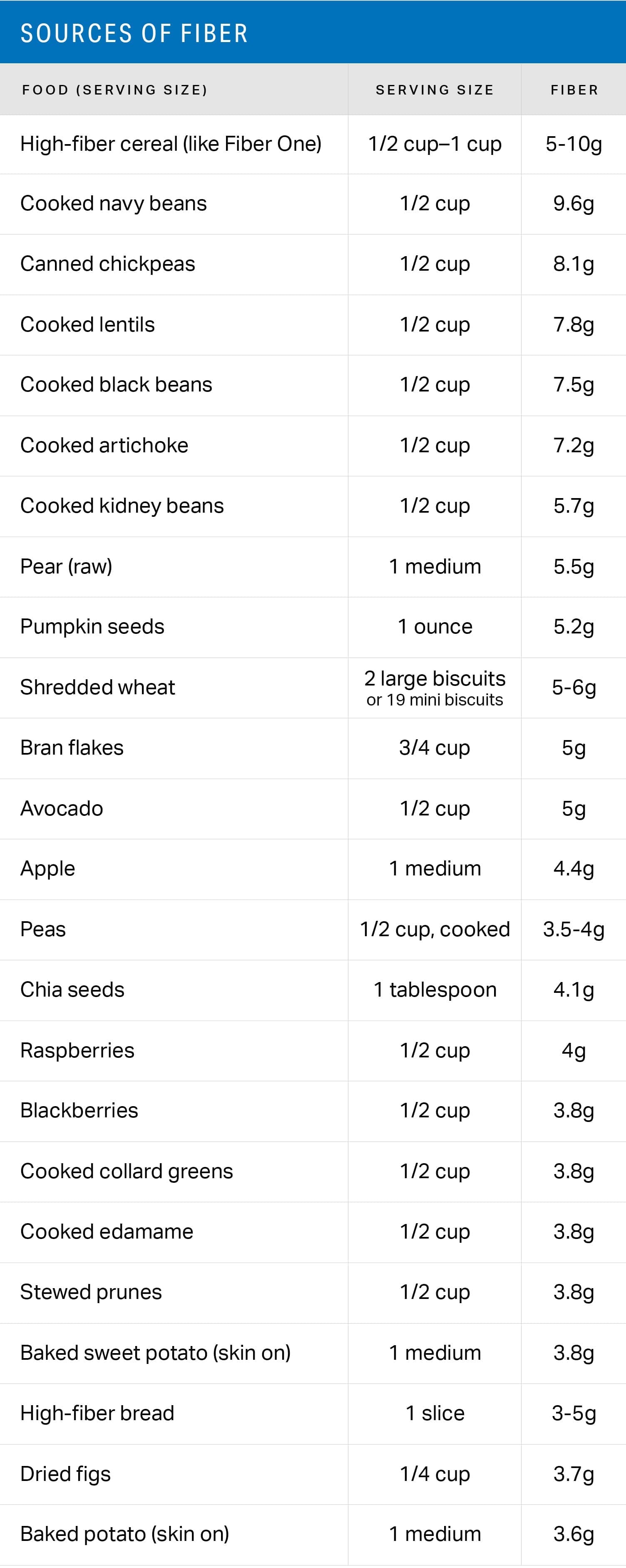Essential Guide to Fiber

Fiber is essential for a healthy digestive tract even though it’s the structural part of plant foods that our bodies can’t even absorb. That said, most of us fall short of the daily recommendations and miss out on the important benefits.
WHAT IS FIBER?
Fiber is a form of carbohydrate found in plant-based foods that cannot be absorbed or digested by the gut. It’s sometimes called ‘roughage’ or ‘bulk’ and occurs naturally in a variety of plant-based foods like fruit, veggies and whole grains.
TYPES OF FIBER
Our understanding of fiber is expanding, however, fiber is generally broken into two main categories:
- Soluble fiber: Soluble fiber forms a gel in the gut, and is particularly helpful for cholesterol control, alleviating diarrhea and promoting fullness. Oats, apples, pears and sweet potatoes are good sources of soluble fiber.
- Insoluble fiber: Insoluble fiber increases stool bulk and promotes regularity and satiety. Insoluble fiber is found in the skins of fruit and vegetables, as well as whole grains and nuts.
For many of us, getting enough fiber is the big focus, however, there are certain situations (like constipation) where the type of fiber consumed makes a difference.
HOW MUCH FIBER DO WE NEED?
The recommended daily intake of fiber is 25 grams for women and 35 grams for men. Put in practical terms, this equates to roughly 1/2 cup of high-fiber cereal, 1/2 cup beans, a pear and 1/2 cup mixed veggies per day.
BENEFITS OF FIBER
1. SATIETY AND BLOOD SUGAR REGULATION
Consuming fiber-rich foods helps us stay fuller for longer, and avoid blood sugar peaks and valleys, which can leave us tired and foggy. Some research suggests consuming adequate fiber helps ward off Type-2 diabetes and promotes weight loss.
2. CHOLESTEROL CONTROL
Soluble fiber is a sponge for cholesterol, trapping it before it gets to the bloodstream. This is one of the reasons fiber is often cited as being ‘heart healthy.’
3. DIGESTIVE HEALTH, THE MICROBIOME AND COLON CANCER
Fiber offers a number of digestive benefits:
- Insoluble fiber promotes laxation and can be useful for alleviating constipation.
- Soluble fiber, on the other hand, is sometimes used to remedy diarrhea.
Emerging research suggests eating enough fiber from a variety of sources can promote microbial diversity in the gut and fortify the microbiome. The microbiome has an important immunological function and is implicated in everything from nutrient metabolism to mental health. - A fiber-rich diet has also been shown to protect against colon cancer.
4. LONGEVITY
Epidemiological research suggests consuming a diet rich in fiber may reduce total mortality risk, as well as mortality risk from cardiovascular disease and all cancers.
FIBER AND GUT HEALTH
Prebiotics support and nourish good bacteria in the microbiome. That is, they stimulate the growth of good bacteria in the large intestine and, similar to fiber, pass through the digestive tract undigested. Some, but not all, sources of fiber are considered prebiotics.
Inulin, fructo-oligosaccharides (fructans/FOS) and galacto-oligosaccharides (GOS) are both sources of fiber and prebiotics.
Resistant starch is a prebiotic, fermentable fiber and type of carbohydrate. It is found in whole grains, green bananas, potatoes and legumes and reaches the large intestine before being fermented by bacteria. Consuming resistant starch appears to be beneficial for blood sugar and appetite regulation.
SOURCES OF FIBER
Fruit, veggies, nuts, whole grains and legumes are packed with fiber.

Fiber is also added to some prepared foods. Beta-glucan soluble fiber, psyllium husk, cellulose, guar gum, pectin, locust bean gum, hydroxypropylmethylcellulose are all examples of ingredients used to boost the fiber content of packaged foods.
TIPS FOR GETTING ADEQUATE FIBER
Start your day with a high-fiber cereal with yogurt and fresh fruit.
- Make half your plate vegetables at lunch and dinner.
- Snack on fruit, raw veggies and whole-grain crackers paired with a protein like Greek yogurt, hummus or string cheese.
- Add beans to soups and salads.
- Add a few slices of avocado to sandwiches and salads.
- Swap white carbs for whole grains like brown rice, whole-wheat pasta, quinoa and whole-wheat/whole-grain bread.
- Try a new high-fiber recipe.